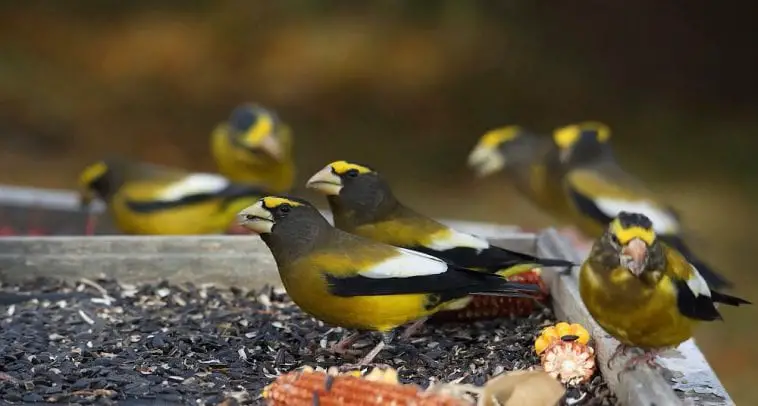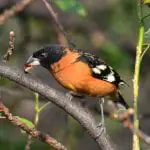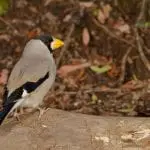Scientific Facts
| Common Name: | Evening Grosbeak |
| Scientific Name: | Coccothraustes vespertinus |
| Life Span: | 15 years |
| Size: | Length: 6.3 to 7.1 inches Weight: 1.9 to 2.6 ounces Wingspan: 11.8 to 14.2 inches |
| Habitat: | Mature coniferous forests, deciduous woodlands, parks, and orchards |
| Country of Origin: | North America and the Rocky Mountains |
Evening Grosbeak Information

The Evening Grosbeak is known for its chunky appearance with prominent bills and colorful feathers. This is often identified as a finch found in large flocks that prefer to eat copious amounts of sunflower seeds.
The Evening Grosbeak is native to the western part of the United States and was unknown before 1890 in the eastern section of the Great Lakes. At present, it breeds along the east of New England as well as the Maritime Provinces. And this movement eastward may be the reason for its spread across the northern prairies and the Northeast.
The Evening Grosbeak is very colorful and is often the bird you’ll find every few years when their large flocks move from their natural breeding grounds up north to seek food and warm shelters in the south. And despite common knowledge of its migration, it’s hard to tell in the western and northern parts of the United States will the Evening Grosbeak show up at a particular winter.
When a flock of Evening Grosbeaks moves in an area, you’ll find them on feeding platforms that offer sunflower seeds. To find Evening Grosbeaks in the wild, you need to listen for their call notes. These birds prefer to forage and build their nests on high trees and areas,
Physical Description

The Evening Grosbeak has a large, heavy-set body with very thick and conically-shaped bills. Their necks are thick, with a full chest with a very short tail.
Just like most animals, males and females vary in many characteristics, but the most obvious is the bird’s colors. An adult male Evening Grosbeak is birds with bright yellow and black bodies. A white patch can be seen on both wings. Males have dark heads with bright yellow streaks just above their eyes.
Meanwhile, females and immature birds are usually dull in color. Females are usually gray with black and white wings. There is a greenish-yellow color around the neck and the flanks. Adult males have pale ivorybills while adult females have greenish-yellow bills.
The size of an Evening Grosbeak is a little similar to the Northern Cardinal; however, this finch has a more compact and thicker body. This bird is smaller than a Blue Jay or a Steller’s Jay. It is considered the heaviest and the largest finches.
The Evening Grosbeak comes in a variety of colors and has three distinct populations, with each one having distinct calls. The name Grosbeak is from the French term “gros-bec” which means “big beak.” It was called Evening Grosbeak because people thought that it only sings during dusk.
Personality
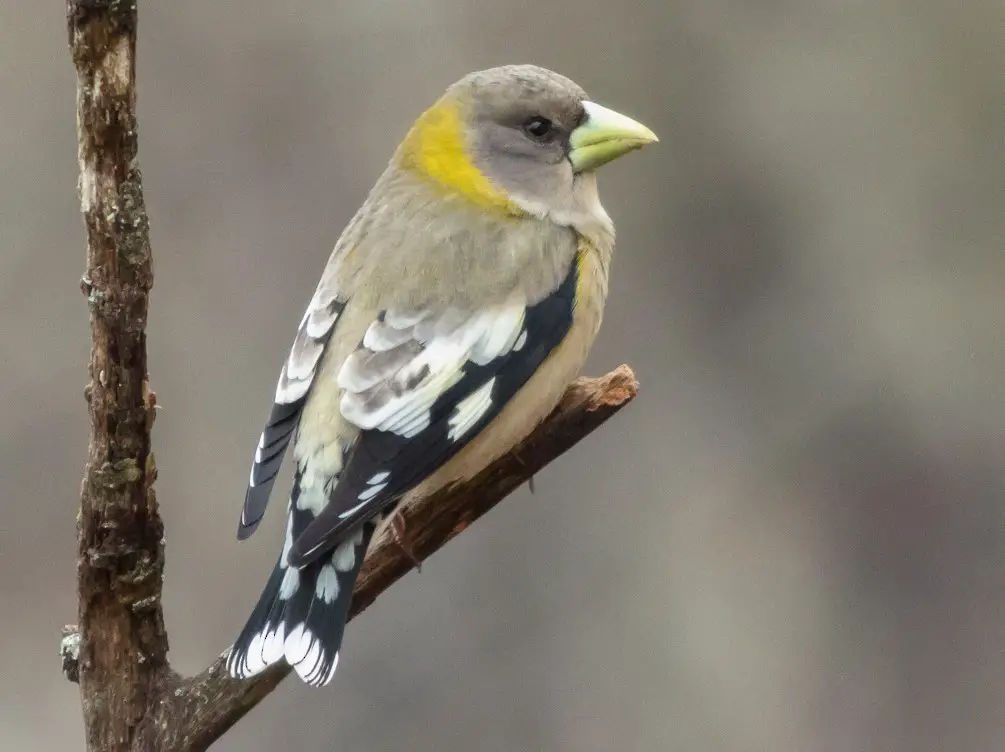
Evening Grosbeaks are social animals and are found in groups most of the seasons of the year. They may “sing” with their buddies as they hang around trees and shrubs. But despite being songbirds by lineage, this bird does not have a regular song; they may even rarely give uneven, short calls or warbles. Evening Grosbeaks have sweet, piercing calls and chirps. Recordings of the Grosbeak’s songs and calls have been recorded by researchers, and they have found distinct individual calls sand flock calls.
But once the breeding season starts, a group of birds will break into pairs, a male and a female. The pair starts a courtship ritual that’s quick and easy and involves some unique rituals and movements. One very noticeable thing about Evening Grosbeaks is that the male is very caring for his mate in such a way that he will offer her food during courtship. Sometimes, he may shower her with attention by feeding her.
The monogamous pair will remain together until their kids are born. The male continues his devotion by feeding the female as she sits on their eggs. The female and male Grosbeaks are also responsible parents. They will take turns feeding their babies, which will rely solely on their parents for food during the first weeks of their lives.
Life Span
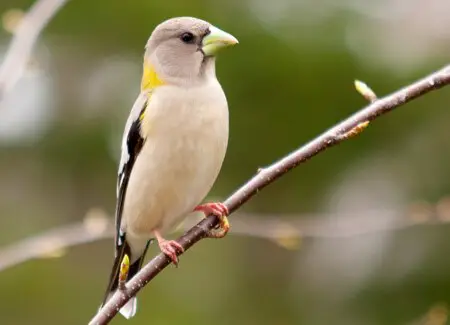
The Evening Grosbeak can live up to 15 years. But lately, conservation actions are in place to save this bird’s population. According to a study of the Evening Grosbeak populations led by the North American Breeding Bird Survey, the number of birds dropped significantly from 1966 to 2015. This is particularly seen in the east, where populations declined around 97% during this time.
Meanwhile, Partners in Flight says that a global breeding number of 4.1 million exists, and around 71% of the population spending a part of their year in the United States, 57% in Canada, and around 5% in Mexico.
Evening Grosbeak has a score of 13 out of 20 forms the Continental Concern Score and is part of the 2016 State of Northern America’s Birds Watch List. This list includes birds that are classified as most vulnerable for extinction with no important conservation actions to reduce threats and declines.
These species have an irruptive nature, making it difficult to make precise estimates. In 2008, Project FeederWatch spearheaded a study and found that the winter range of this bird has declined. The Evening Grosbeaks’ numbers were around half their population with flock sizes reduced by 27% in early 2000 compared to the late 1980s.
Evening Grosbeaks were unheard of in the middle of the 19th century until these birds started to expand eastward. This expansion has led to the spread of the box elders and possible outbreaks of insects found in forests like the spruce budworm.
In the 1920s, Evening Grosbeaks are regular winter species in New England. Their population peaked during the 1970s and the 1980s. Experts believe that their decline may be due to logging plus other forest developments in the northern part of North America.
Other reasons that may have contributed to the declining population of Evening Grosbeaks are salmonella outbreaks, West Nile virus, House Finch disease of the eye, and the reduction in the number of spruce budworms as well as other insects in the forest.
Spraying of forests in the United States and Canada and climate changes may affect the population of Evening Grosbeaks. It is also possible that this species may simply disappear from this area altogether.
Families and Species
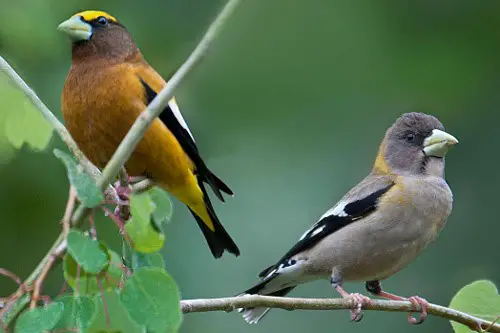
Evening Grosbeaks belong to the Fringillidae family and are closely related to the Pine Grosbeak, Gray-crowned Rosy-Finch, Black Rosy-Finch, Brown-Capped Rosy-Finch, House Finch, Purple Finch, Cassin’s Finch, Common Redpoll, Hoary Redpoll, Red Crossbill, Cassia Crossbill, White-winged Crossbill, Pine Siskin, Lesser Goldfinch, Lawrence’s Goldfinch and the American Goldfinch.
These birds have almost the same body with the same large but short beaks and colorful feathers. What makes birds different is that these are found all over the world and therefore have different preferred environments where they can remain thrive and reproduce.
Reproduction

Courtship is quick and rarely observed. But experts say that possible courtship behavior may still be observed. The male may dance with his head and tail raised as his wings droop and vibrate. The male will swivel back and forth, and these are in an attempt to court the female.
Males may also bring food to the female and feeds her. Still, another courtship dance is seen, but this time, both the male and female birds bow alternately.
When it comes to nesting, Evening Grosbeaks prefer to nest very high amongst the trees or on top of large bushes. You’ll find nests near the top of black spruce, red spruce, white spruce, Norway spruce, Engelmann spruce, Jeffrey pine, jack pine, balsam fir, Douglas fir, ponderosa pine, paper birch, sugar maple, and willow.
Unlike other birds, it is not known whether the male or female bird selects the site, but when it comes to Evening Grosbeaks, the female does more work building the nest. The female will collect materials to build her nest from the ground, or it may break twigs from trees using its large beak.
The female Evening Grosbeak will build a flimsy nest with a saucer-like appearance. The framework of the nest is made of twigs and roots while the walls and floors are made of grasses, lichens, rootlets, or pine needles.
The Grosbeak’s nest measures 5 inches across, and 5 inches high, The nest’s inner cup is around 3 inches and is about an inch deep. The female will lay around 2 to 5 eggs with 1 to 2 broods in a year. She will incubate her eggs for a period of 12 to 14 days, while the nesting period lasts from 13 to 14 days. The male will remain with the female and feed her during incubation so she won’t have to leave her nest.
The eggs are very lovely, just like its parents are color light blue to light green covered with brown or purple spots or blotches. Each egg measures 2 to 2.6 cm in length and 1.4 to 1.8 cm in width. The hatchlings will emerge helpless with closed eyes and have a dark skin that’s partially covered with white down.
Both the male and female will feed their hatchlings. They will take turns hunting and foraging for food on the forest floor and canopy, and what they get, they bring home to very hungry chicks. The young Grosbeaks will leave their nest in about 2 weeks after they hatch
Behavior

Evening Grosbeaks are very social and are usually found in flocks, especially during wintertime. This is when these birds forage near the treetops to look for insects and insect larvae during the summertime. During the winter, Evening Grosbeaks prefer to eat seeds, berries, and fruits.
However, during the breeding season, it’s a different story. These birds break into pairs during the breeding season as they look for mates, create nests, and raise their offspring afterward.
Evening Grosbeaks are not aggressive and will not compete with their kind throughout the year. But in winter, males may drive away females and other younger males but will not defend their feeding areas during the breeding season. Experts say that this happens because their food sources start to become more abundant in local areas.
But during the nesting season, these birds are found in monogamous pairs. The male and female court quickly and quietly without any display of affection or song. As the two Evening Grosbeaks start a family, they may tolerate other bird species nearby but are not in good terms with other species.
Just some of the species that Evening Grosbeaks will chase away are American Robins, Brown-Headed Cowbirds, Hairy Woodpeckers, phoebes, and more.
Evening Grosbeaks may or may not visit your backyard yearly because these show up irregularly during the wintertime. But if you leave a feeding platform with sunflower seeds, then these birds may just show up. Aside from sunflower seeds, you can also leave berries, tree buds, and maple shrubs. Take note that the Evening Grosbeaks are large birds, so don’t place food inside tube feeders but use platform feeders instead.
Evening Grosbeaks are irruptive or irregular winter migrants. It’s hard to predict where these will show during the wintertime in a given year.
Eating Habits
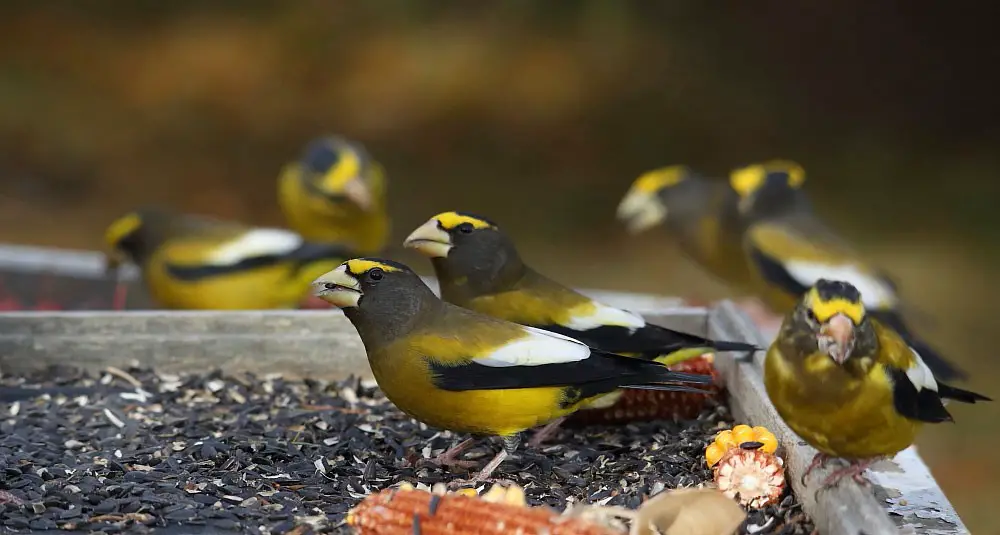
Evening Grosbeaks prefer to eat small species of animals as well as a variety of plants, seeds, and fruit. Its diet is mostly seeds, berries, and insects. Seeds like the seeds of ash, maple, locust, box elder, and other trees are their favorite.
This bird also loves buds coming from deciduous trees, weed seeds, small fruits, and berries. Evening Grosbeaks will manipulate fruits such as a fleshy cherry just to remove the skin to expose the flesh and remove the seeds.
In the summertime, Evening Grosbeaks will eat mainly insects because these are very abundant during this time. These birds will forage for food on shrubs and trees altogether. You may also see a group of them on the forest floor looking for food.
When in the area, Evening Grosbeaks will visit feeding trays that have all kinds of seeds, most especially sunflower seeds. It will also eat fine gravel to get the necessary minerals for growth and will also eat salts. The huge and colorful bill is not just for show but also good for breaking seeds with ease. Sunflower seeds are very hard to crack open. You may need to soak seeds in water or using a nutcracker to open these. But the Evening Grosbeak can do this by just cracking the seeds using their mouths.
Young hatchlings will require soft food compared to adults. Their parents will feed them berries and small insects until these are old enough to leave the nest and fend for themselves.
Water
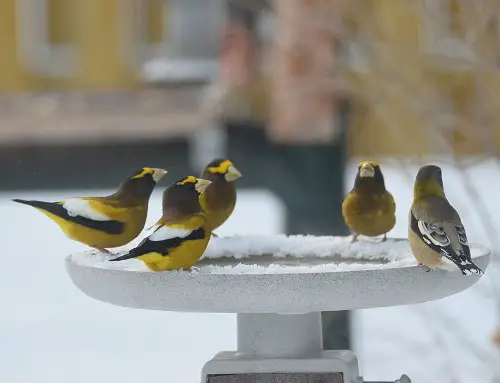
Evening Grosbeaks are just like other birds as they drink water from time to time. They are not water birds, so you won’t see them floating on water. You may see them drinking water though using their large beaks.
And to attract Evening Grosbeaks in your garden or yard, don’t just leave seeds and fruits on feeding trays. Add a shallow basin to be used as a birdbath. These birds may stay on feeding trays and inside birdbaths with other birds of the same species.
Habitat
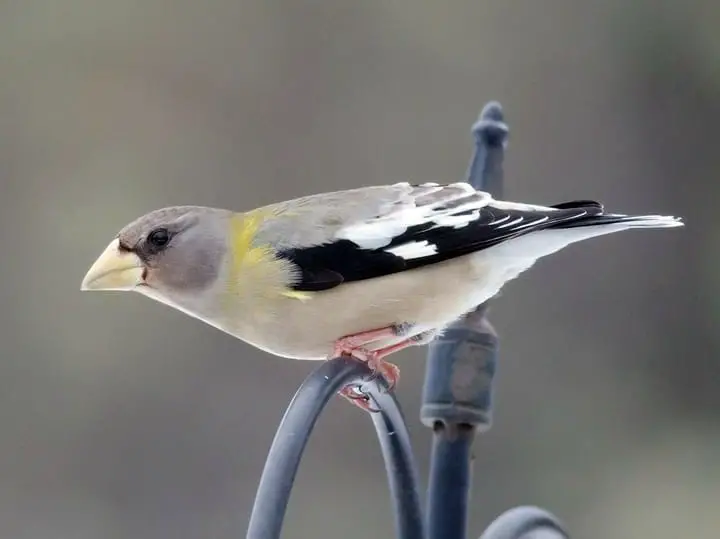
The Evening Grosbeaks are abundant in the coniferous forests of the northern part of North America as well as the Rocky Mountains. This includes trees like spruce-fir, pinyon-juniper, aspen forests, and pine-oak.
You will also find them in deciduous woodlands, orchards, parks, and farms. Groups of Evening Grosbeaks will breed as far as Mexico. During the wintertime, these birds live in coniferous forests as well as in deciduous forests, urban areas, and suburban areas. When these birds are hiding out in the wintertime in an urban area or near human homes, these may stay near gardens and yards where there are tray feeders.
Cage/Enclosures

Captured Evening Grosbeaks are mostly placed in large cages, preferably with the company of other finches. Take note that this is not recommended. As much as possible, you must leave feeder birds alone and just let them forage for food in your yard or garden.
But if you must keep this bird or any wild bird in a cage, the enclosure must be large to allow the birds to take short flights. Keep males and females together, and if you want to let them mate, include live tree branches and shrubs inside your enclosure.
The enclosure should have a lot of perching sites and places where the birds can hide, sleep, and play. Since this bird is social, make feeding trays large and water dishes larger. The feeding trays should contain food that Evening Grosbeaks prefer to eat like sunflower seeds. Allow these birds to feed without being disturbed, especially by other pets.
Making your food trays in your backyard to take advantage of visiting Evening Grosbeaks is another way to support the population of these lovely birds. We will explain how to make a simple food tray and how to make sure Evening Grosbeaks will visit your yard regularly later.
As much as possible, leave Evening Grosbeaks alone and don’t take one as a pet. Even if this species of birds are still available in good numbers in the wild, it may not take long for these birds to disappear if we are not careful.
Availability – Where to Get One?
You can’t buy an Evening Grosbeak from a pet shop or a pet trade center. You won’t find this sold online, as well. The only place to get one is if you capture one in your yard in case this bird is native in your area.
How to Care for an Evening Grosbeak?
An Evening Grosbeak is a wild feeder bird that lives in forests but may also prefer to settle near human homes because these are the best areas where they can easily forage for food. If you see Evening Grosbeaks in your yard or garden or if you live near a coniferous forest, then you can help these birds find food and to live safely as well.
One of the best ways to ensure that populations of Evening Grosbeaks increase everywhere is to encourage homeowners to make bird feeders in their yards. Since these are moderately-sized birds, a tube feeder or any narrow feeding container is not enough. Use an old tray or frying pan to hold their food.
Don’t place the feeder on the floor or on an area where predators like cats can easily sneak in and snatch these birds. Hang the tray feeder up high where a cat and other mammals can’t get in. Attract more birds by using sunflowers because this is their favorite food. You may also add fresh fruits, dried fruits, and seeds to the mix.
Commercial bird food is also available, but make sure that these are organic bird food and contain seeds that these birds will like.
Aside from food, place water trays, or birdbaths in your garden. If these finches arrive during the wintertime, then you may consider a heated birdbath. This is a unique electric garden accessory that’s similar to a heated dish or plate. Birds will love to wade, drink, and to take a bath in this heated water. All you need to do is to change this water frequently and to make sure that your electrical connections are safe to use outdoors.
Making a small bird shelter is another way to encourage finches from returning. You can buy a wooden bird home from a pet shop, but make sure the opening can fit Evening Grosbeaks. Take note that this bird is larger than the average feeder bird.
But if you have woodworking skills and you have materials or tools to make one at home, you may consider making your bird boxes. You’ll find tutorials on how to make basic bird boxes online.
Since Evening Grosbeaks prefer to build their nests on top of trees, you may install your DIY bird boxes or store brought boxes at this height. Don’t place boxes in your yard unless you have tall trees where the birds can be safe.
Monitor the population of Evening Grosbeaks in your area. Take photos and video evidence of birds in your feeder and compare their numbers to next time they come back in your yard. Your efforts will determine if the population of the Evening Grosbeaks is declining or multiplying in your area.
FAQs
Do Evening Grosbeaks migrate?
Evening Grosbeaks are nomadic, which means these birds will settle to where food is abundant and will look for other places to stay when it has consumed food in the area. It’s also tough to predict where these birds will show up in the winter, but these usually migrate in the western and northeastern parts of the United States.
How do you attract Evening Grosbeaks in your yard?
To attract Evening Grosbeaks in your hard is easy. First, make sure that these birds have appeared in your area before; if so, prepare a food tray containing its favorite food, sunflower seeds. Add dried fruits and other types of seeds, as well.
Will Evening Grosbeaks eat fruit jelly?
Yes, fruit jelly-like grape jelly is a part of feeder birds’ diets like the Evening Grosbeak. Other birds like woodpeckers, orioles, and more love to eat any kind of jelly together with seeds and dried fruit.
What do Evening Grosbeaks eat during wintertime?
During the winter season, where it’s hard to look for insects, Evening Grosbeaks are contented with plant-based diets like seeds and small fruits. This is why if grosbeaks fly to your area for wintertime, leave some seeds and dried fruit on a feeding tray for these birds to eat.
Are grosbeaks finches?
Yes, the Evening Grosbeak is a typical finch. It belongs to the family Fringillidae and is among the best known in North America. These birds have chunky bodies with big bills and are known to stay in groups.
Will grosbeaks eat oranges?
Yes, grosbeaks will eat oranges, whether these are dried or fresh. You can place dried oranges in its feeding tray or cut oranges up so these will be easier to eat.
Are grosbeaks rare?
No, Evening Grosbeaks are not rare birds. These birds can be seen in forests and urban areas. The population of grosbeaks is slowly declining according to experts, and thus people should try hard to keep their numbers up by leaving them alone.
Are Evening Grosbeaks aggressive?
No, Evening Grosbeaks are not aggressive. These birds will happily take food from trays left in yards and gardens and will leave people alone.
What are the rare characteristics of an Evening Grosbeak?
Evening Grosbeaks are in a variety of colors and are known for their unique songs and calls. The song and call are not distinct to this species and are not about a particular song despite being called songbirds.
Will grosbeaks mate for life?
Yes, when a male and a female Evening Grosbeak meet, they will mate for life. Usually, grosbeaks will be with each other, will eat and play together, but when the breeding time comes, will remain with their partners only.

